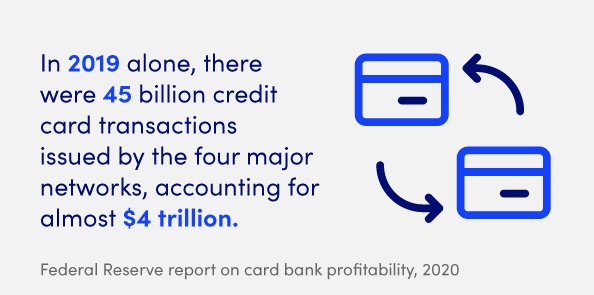Summary
The credit card industry is a big business, and it is dominated by a handful of major banks and payment networks. Here’s how the credit market breaks down, and how it’s been affected by the pandemic and new developments in technology and security.
The content on this page is accurate as of the posting date; however, some of our partner offers may have expired. Please review our list of best credit cards, or use our CardMatch™ tool to find cards matched to your needs.
The credit card industry is a big business, and it is dominated by a handful of companies.
American consumers collectively were juggling $974 billion in credit card debt as of the end of 2020, according to the Federal Reserve consumer credit report.1 The top 10 card issuers held 81.4% of credit card balances outstanding in 2019.2
There were some 45 billion U.S. general-purpose credit card transactions in 2019 (based on cards issued by the four major networks – Visa, Mastercard, American Express and Discover), accounting for almost $4 trillion in dollar volume.2

General-purpose credit card payments had a value of $3.64 trillion in 2018, up 9.1% from 2015.3 And the total number of general-purpose credit card transactions in the U.S. was 40.9 billion in 2018, according to the 2019 Federal Reserve Payments Study. They accounted for 91.5% of all credit card payments, compared to private label cards at 8.5%.3
See related: How do credit card companies make money?
Top networks by market share
Visa
Visa is the largest of the four major U.S. credit card networks. For the 12 months ending Dec. 30, 2020, Visa’s U.S. credit payments volume was $1.97 trillion, down from $2.15 trillion the year before.4
There were 343 million Visa credit cards in circulation in the U.S. and 798 million Visa credit cards in circulation outside of the U.S. at the end of September 2020.4 For comparison, there were 336 million Visa credit cards in circulation in the U.S. and 737 million cards in the rest of the world in September 2017.5
Mastercard
Mastercard’s U.S. credit purchase volume was $837 billion at the end of December 2020, down from $909 billion the previous year.6
There were 249 million Mastercard credit cards in the U.S. and 725 million cards in the rest of the world at the end of March 2021. By comparison, there were 243 million Mastercard credit cards in the U.S. and 705 million cards in the rest of the world the year before.6
American Express
American Express saw its U.S. cardholders spend $828 billion in 2019, up from $778 billion the year before. For 2020, there was a slowdown, and American Express cards generated $693 billion in purchase volume in the U.S.7
At the end of 2020, there were 53.8 million American Express credit cards in circulation in the U.S. and 58.2 million in the rest of the world. That compares to 54.7 million cards in the U.S. and 59.7 million in the rest of the world, in 2019.7
Discover
The Discover network had a credit purchase volume of $149 billion in 2020, down from $151 billion in 2019.8
Expanding the customer base
The COVID-19 pandemic may have led lenders to tighten their lending standards, at least at the beginning of the health and economic crisis.
TransUnion reports subprime credit card originations dipped to 1.84 million in the second quarter of 2020, down from 2.53 million in the first quarter of that year. However, they rebounded in the third quarter, reaching 2.80 million subprime credit card originations.9
TransUnion has also found that the number of credit card accounts dropped in 2020. In the fourth quarter of 2020, there were 452.8 million card accounts, down from 454.7 million in the fourth quarter of 2019.9 In the first quarter of 2021, though, the number of accounts rose to 454.6 million, TransUnion reports.14
However, data from Experian show that Americans are handling the pandemic well – at least as far as their credit is concerned. The average VantageScore of credit card consumers rose from 682 in 2019 to 688 in 2020.10 During this period, the average number of cards held by the average consumer dropped slightly from 3.07 in 2019 to 3.0 in 2020.
Also, the average number of retail credit card accounts dropped from 2.51 in 2019 to 2.42 in 2020, according to Experian.10
And average credit card balances are down from $6,629 in 2019 to $5,897 in 2020.10
See related: Card balances dropped in 2020 for the first time in nine years
The future of cards
One major threat that continues to impact cards in circulation is security. The Federal Trade Commission reports that there were 393,207 reports of credit card fraud related to identity theft in 2020.11
Credit cards in the U.S. have traditionally used a magnetic stripe, but a nationwide migration to EMV payment technology has been underway. EMV – which stands for Europay, Mastercard and Visa – is a global standard in which cards have computer chips that dynamically authenticate transactions instead of relying on easy-to-copy magnetic stripes.
At the end of 2020, there were approximately 10.8 billion smart chip cards deployed worldwide12, per EMVCo. In the U.S., about 73% of card-present transactions between January 2020 and December 2020 were EMV, according to EMVCo.12
Another technology likely to play a bigger role in the future is contactless cards. The pandemic has created even more interest in the technology as consumers look for ways to minimize physical interaction with other people.
Nearly two-thirds of consumers (65%) surveyed by Visa at the end of 2020 said they would rather use contactless payments as much as or more in the future than they currently use them. Only 16% said they would revert to non-contactless payments after the pandemic.13
Bottom line
There was a slowdown in credit card usage in 2020 as pandemic-related lockdowns meant there were fewer avenues for consumers to spend their money. The credit card market is growing overall, though, with new technologies likely to have an impact.
Sources
- Federal Reserve Consumer Credit Report (G.19)
- Fed report on card bank profitability, 2020
- 2019 Federal Reserve Payments Study
- Visa operational performance data, fourth quarter 2020
- Visa operational performance data, third quarter 2018
- Mastercard supplemental operational performance data, quarter ended March 31, 2021.
- American Express 2020 annual report
- Discover 2020 annual report
- TransUnion Q4 2020 Industry Insights Report
- Experian State of Credit 2020 Report
- Federal Trade Commission’s Consumer Sentinel Network Data Book 2020
- EMVCo, Worldwide EMV Deployment Statistics
- The Visa Back to Business Study 2021 Outlook
- TransUnion Q1 2021 Industry Insights Report
Editorial Disclaimer
The editorial content on this page is based solely on the objective assessment of our writers and is not driven by advertising dollars. It has not been provided or commissioned by the credit card issuers. However, we may receive compensation when you click on links to products from our partners.






